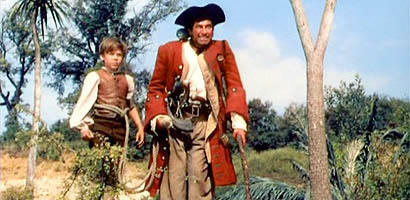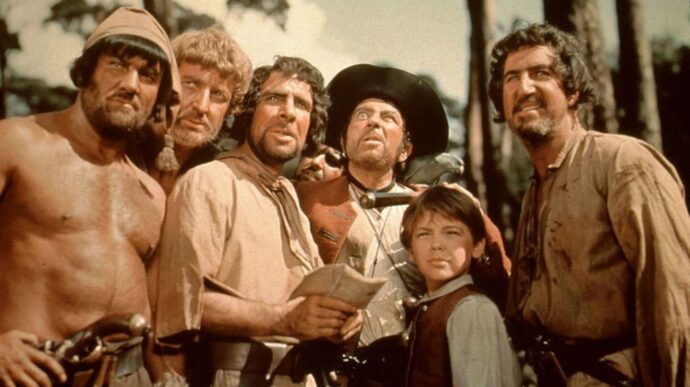Before beginning this Plus or Minus, focusing on Treasure Island, a quick disclaimer. Once again, let me apologize for this incredibly delayed piece. A combination of personal issues and writer’s block caused a huge delay here. But again, I promise to get things back on track with this series. And now, let’s begin!
Plus or Minus is a series detailing and analyzing every feature film now streaming on Disney+. It combines the unique history all these films share, their cultural impacts, and their qualities, or lack thereof. From timeless classics, to acquired hits, to DCOMs, no stone will be left unturned.
This Plus or Minus for Treasure Island is a historic one. But first, a quick synopsis. Bobby Driscoll plays Jim Hawkins. Hawkins is a young boy living with his single mother at the country inn they run. As luck would have it, a pirate named William Bones steps into the inn and gives Jim a treasure map. A treasure map previously from the famed buccaneer Captain Flint, promising incredible riches. And thus, Jim soon finds himself on board a pirate ship on a quest to find the fabled Treasure Island.
During his time on board, Jim Hawkins befriends Long John Silver, the chef of the ship. Silver is played by Robert Newton and despite their friendship, Silver isn’t quite as kindly as he may seem. What follows is an epic adventure full of pirate battles, backstabbing, treachery, revealed secrets, and much, much more.
The Dawn of a New Era
The 1950s is arguably the most important decade for Disney. Specifically, the massive expansion in the Disney name and company. Even more so than today, this was the decade where Walt made his company into the machine it’s known for. The money troubles plaguing Walt’s animation studio prompted the man to diversify his company. Create more than just cartoon shorts and the occasional feature animation project. The big headlines everybody knows were Walt’s utilization of the new television medium and the creation of Disneyland. Yet an overlooked aspect within Disney history was the development of live-action Disney features.
This was not the first time Disney worked in a live-action medium. In fact, the earliest instance was with the 1920s Alice Comedies, where a live-action girl interacted with cartoon characters. Then of course there’s films like Fantasia or Fun and Fancy Free which had live-action wraparounds. The Reluctant Dragon was mainly live-action with a few animated shorts thrown in. Song of the South and So Dear to My Heart followed suit from the Alice Comedies, blending live-action and animation together.
However, Treasure Island is nothing like any of the previous movies. There are no animated characters, sequences, or shorts. It’s real sets, real people, real action. In a way, this was a risky venture. Since Disney was known for their cartoons, would there be interest from audiences in something so against type? In fact, did Walt Disney have a good idea on what made a good live-action film?
As it turns out, the film was a financial and critical success. And years later, this is the one defining adaptation of the movie. At least, the one defining adaptation without any Muppets or Goo Goo Dolls songs.

The Surprising Dark Atmosphere
The one aspect that is surprising to me is how grim and intense the film can be. Obviously Disney has done mature subject matter before. And there’s certainly a lot of corny and silly moments thrown in there. But there’s some intense stuff here. Gunplay, knife throwing, stabbing. It can get brutal at points, though it certainly never goes into R-rated territory.
These more grim undertones are some of the best aspects of the film. A lot of the action is well-shot if standard and there’s plenty of great moments of suspense thrown in. Yet at the same time, there are a few corny and silly moments thrown in, particularly in the acting. But it never goes too overbearing or distracting. If anything, it makes this an interesting time capsule for the pirate movies of old and brings decent personality to the piece.
A True Pirate’s Life
By far the best thing about this movie is Robert Newton as Long John Silver. Newton is about as stereotypical of a pirate as you can get. His accent, hammy delivery, and grunt work all fit the pirate mold. Many film historians have even argued Newton’s acting defined the stereotypical pirate character we all know and love today. Alongside a slew of other memorable character actors, there’s a lot of great pirate moments abound, even if it is romanticized and kid-friendly. Sword fights, grand expeditions, the works. This is helped also by the solid direction from Byron Haskin.
Haskin’s film is a lovely one to look at, with some creative sets and some gorgeous matte painting backgrounds that feel like the original book come to life. At the same time, Haskin also directs the many action scenes with fast editing and quick pace, making the film quick and exciting throughout the run time. The climax in particular is really exciting stuff, as the film escalates from one major revelation to the next.
An Out-There Finale
The one major drawback that pulls Treasure Island away from greatness is the screenplay. It’s almost too straightforward of an adaptation and there’s no real exciting pieces of dialogue or major story revelations. This is most potent in the third act, when Jim Hawkins and the crew finally arrive to Treasure Island. The film quickly goes off the rails upon the introduction of the island survivor Ben, as things get more ridiculous and nowhere near as well-shot or intense as before.
And really, the writing is the one aspect that holds the entire movie back. It already starts out on the generic side, with little surprise, intrigue, or depth. But by the time the end rolls around, things get more convoluted and silly and it never picks itself up from this. And while it is a faithful adaptation of the original Stevenson novel, that doesn’t excuse the poor translation. A film should work well on its own and create a solid flow from each story beat.
Plus or Minus?
Choosing Plus or Minus for Treasure Island is an easy one. However, I would be lying if I said I loved Treasure Island all that much. While pretty to look at and fun and suspenseful at certain points, it’s still a touch too generic to really stick in one’s mind or find much to talk about. And the last act does lose a lot of momentum.
Yet at the same time, there’s still plenty of great stuff to enjoy. As said before, there are some creative moments, the matte paintings are something, and Robert Newton especially makes this a fun watch. And for historical value, it’s certainly fun to see how this would go on to give out the likes of Mary Poppins, 20,000 Leagues, and Pirates of the Caribbean.
Between Plus or Minus for Treasure Island, it’s a marginal Plus, but a Plus all the same.
NEXT TIME: We swing back to animation with the surreal Alice in Wonderland. It’s gone through some re-evaluation lately, but where do I stand on this?
